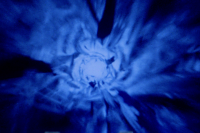Hyperspace Travel
From GURPSworld Wiki
Hyperspace is a method of faster-than-light travel. It is typically described as an alternative region of space co-existing with our own universe which may be entered using an energy field or other device.
Trips through hyperspace are colloquially referred to as "skips," as a ship in hyperspace is thought to be analogous to a stone skipping across the surface of water.
To make a hyperspace journey, the pilot must first plot a course using Navigation (Hyperspace). The pilot must then make a Piloting (High Performance Spacecraft) route to pilot the ship to a proper location and accelerate to the proper speed for entering hyperspace.
Plotting a Course
Plotting a course through hyperspace involves using real-space as a reference point. A hyperspace course must be plotted so that it avoids gravity wells, nebulae, and other phenomena that tend to disrupt hyperspace travel. The real-space distance in parsecs from origin to destination is used as an average distance. The maximum real-space distance which may be safely traversed through hyperspace in a single skip is 33 parsecs.
Known Space
Travel through known space is often made easier through the use of published maps that depict the shortest real-space routes that may be taken advantage of for hyperspace travel. To plot a hyperspace course through known or mapped space, roll vs Navigation (Hyperspace). Each attempt to plot a course takes 30 minutes. The use of a navigational computer is necessary, otherwise a -10 penalty is applied. Halve the margin of success; each point reduces the length of a journey by 5%, to a maximum of 30%, of the mapped distance.
Unknown Space
To plot a hyperspace course through unknown or unmapped space, use the standard Size and Speed/Range Table, and substitute "parsecs" for "yards." Apply the range penalty to the Hyperspace (Navigation) roll. The GM may apply additional penalties for gravitational anomalies and similar unknown hazards. Apply any margin or success or failure to the Piloting (HPS) roll. It is possible for a successful Piloting roll to make up for minor errors in Navigation.
Failures
The relationship of distance-plotted to the resulting distance-off-course resembles a Fibonacci sequence rather than a direct relationship, i.e. the longer the course plotted, the greater the error resulting from a failed Piloting roll. A failed 1pc journey might throw you off 1 ly or more. A failed 10pc voyage could put you several parsecs off-course. Failure to Pilot a 33-parsec hyperspace journey could put you in another sector, and the results of a critical failure could be catastrophic.
